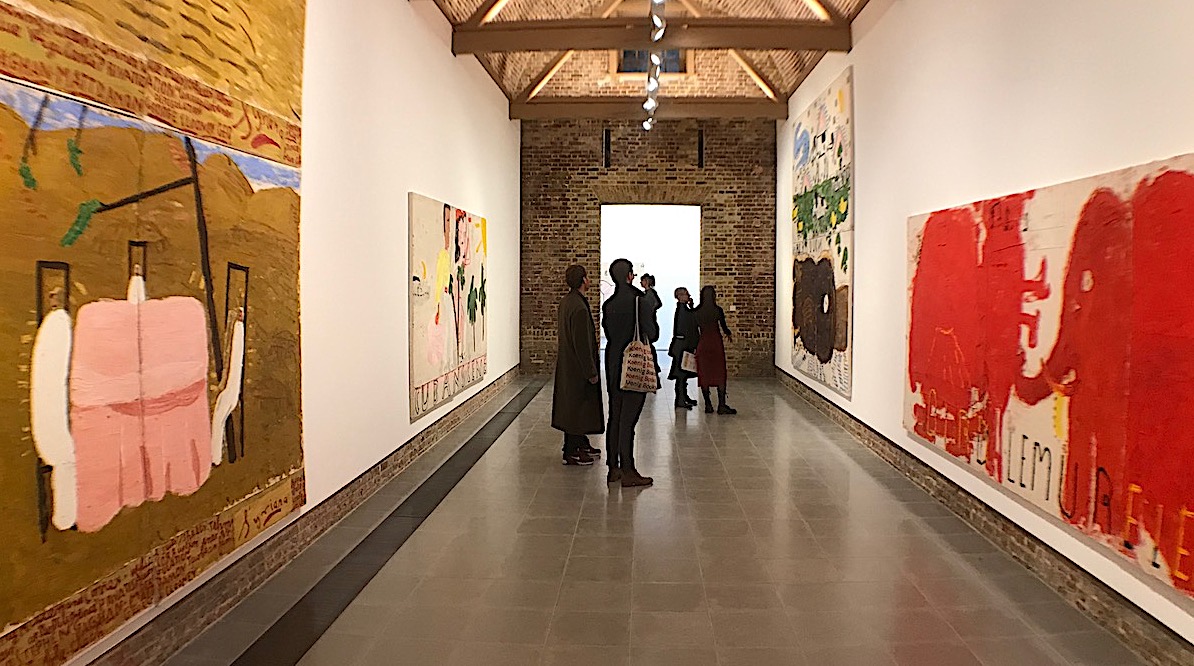With Christmas 2017 and New Year 2018 behind us we return to the normality of the London art gallery offerings. This feature explores Various Rooms at Tate Modern / National Gallery / Whitechapel as well as some of the lesser known galleries around the capital. January is usually a quiet month but with the London Art Fair looming and the relaunch of the Hayward Gallery there is a lot to look forward to.
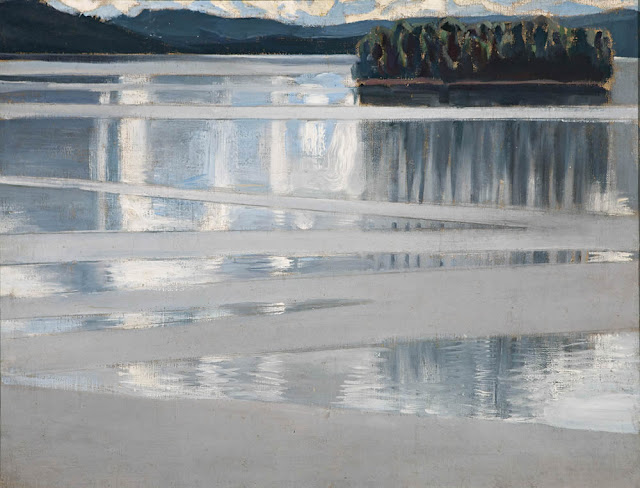
Akseli Gallen-Kallela, Lake Keitele, 1904 (a slightly earlier version than the National Gallery’s own, with more of the abstracting ‘wake of a Kalevala boat’ effect in the foreground)
It’s natural to think in terms of galleries and exhibitions, but what about individual rooms in large institutions? Thomas Ruth is the main reason to visit the Whitechapel just now, but ‘The Upset Bucket’ is a wonderful selection from the ISelf Collection of 28 artists looking at how we project our identity through consumer choices: cue gold and caviar, bins and trash. Several whole room installations are of course core to the Tate Modern’s top current show – the Kabakovs – but two rooms of white works would also justify a trip: ‘Painting with White’, curated by Tanya Barson, and a display of Maria Bartuszová’s under-known work. Not to mention the full version of Tehching Hsieh’s One Year Performance 1980-1981with all 8,760 of the photos taken hourly. And the various loans make up a Gallen-Kallela overview in Room 1 of the National Gallery, including all four versions of the seminal Finn’s 1904-05 views of Lake Keitele.
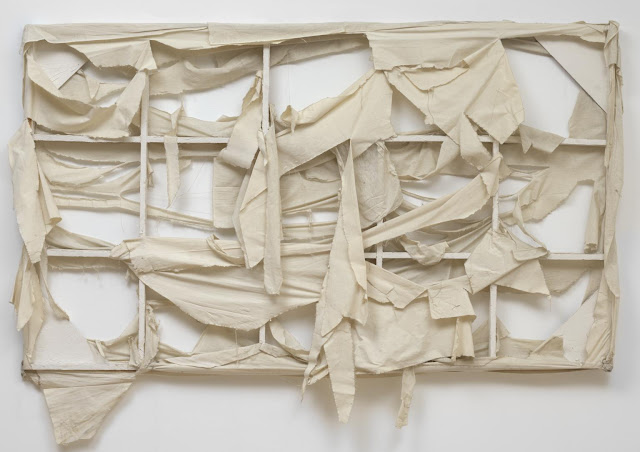
Michael Buthe: White Painting, 1969 at Tate Modern
______________
Secular Icons in an Age of Moral Uncertainty @ Parafin, 18 Woodstock St – Bond Street
To 2 Feb

Installation view with Indrė Šerpytytė and Mimosa Echard
Quite apart from the matter of what’s an icon nowadays, Coline Milliard’s five artist selection for Parafin lures you into apparent abstraction with attractive composition and colour, only for closer examination to reveal a backdrop of violence. Simon Fujiwara achieves more varied effects than I’ve seen previously from his patent process of shaving the fur off coats and reconfiguring them to show the construction behind what was, after all, a murder. Indrė Šerpytytė’s elegant and seemingly cool double-sided towers of light derive their colours from internet searches for images of decapitation. Mimosa Echard works on top of horror movie stills to make the seriesBraindead. You get the picture… well, not the picture, actually, but you see where the non-pictures tend.
Simon Fujiwara, Fabulous Beasts (Bluewashed Mink), 2017. Shaved fur coat on wooden stretcher frame, 175 × 100 cm.
______________
Rose Wylie & Wade Guyton @ Serpentine Galleries – Kensington
To 8 Feb (Guyton) / 11 Feb (Wylie)

Rose Wylie: Choco Leibniz, 2006 – 366 x 305 cm
Both Serpentine Galleries feature artists who’ve found a highly distinctive visual language. Rose Wiley’s cheerfully dispenses with convention in her thrillingly free and spontaneous-looking accumulations of floating memories and sensations, featuring her wartime experiences alongside films, animals, football, tennis, skating… The installation aces the Sackler’s spaces, with the multi-panel works particularly at home. Here she is, in the show’s simplest and least colourful painting, eating that most philosophical of biscuits, the Choco Liebniz. Back at the old Serpentine, Wade Guyton – much lower key – continues to develop the range of his his modern style of diptychs – doubled computer print-outs that push the capabilities of the equipment to a limit which becomes painterly.
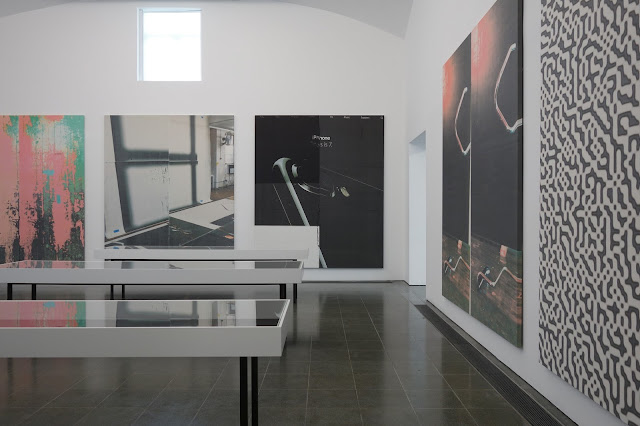
Wade Guyton: installation view
______________
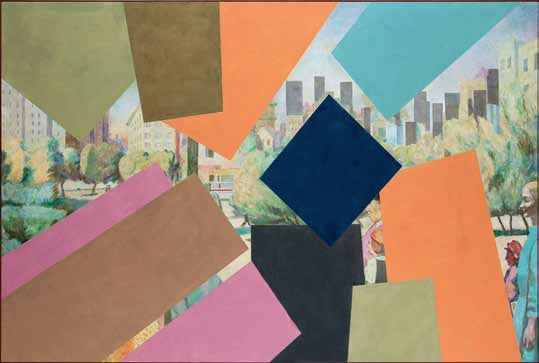
Ilya & Emilia Kabakov: Quotations @ Sprovieri, 23 Heddon St (also at Tate Modern)
To 27 Jan
Ilya Kabakov: Quotations #1, 2012
The Tate’s Kabakovs’ retrospective (to 28 Jan) is a must-see, though it has been criticised for having too many recent paintings when installations are preferred. I disagree, but it is true that the choice of paintings (which are Ilya’s work alone) is a bit unbalanced: lots of the image and history layering of the ‘Two Times’ and ‘Collage’ series, but only one each from the superb ‘Under the Snow’ and ‘Colourful Noise’ series, and nothing from the ‘Quotations’. So it is a worthwhile pendant to see two of that last set. In these, realistic elements are not part-covered by snow or lost in TV-like static, but lie behind a luminescent supremacist-style ‘fence’. Sprovieri also shows the collaborative ‘unfinished installation’, the text for which explains, alluding perhaps to the plans for a new nation, that ‘looking at a building under construction is much more interesting than looking at a finished one’.
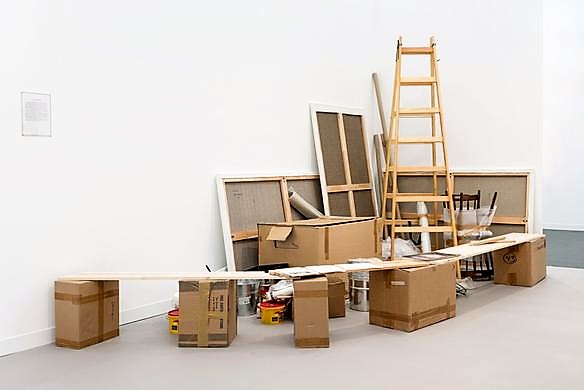
Ilya & Emelia Kabakov: Unfinished Installation, 1995-2017
______________
Combining Materials @ Rosenfeld Porcini, 37 Rathbone Street – Fitzrovia
To 10 Feb
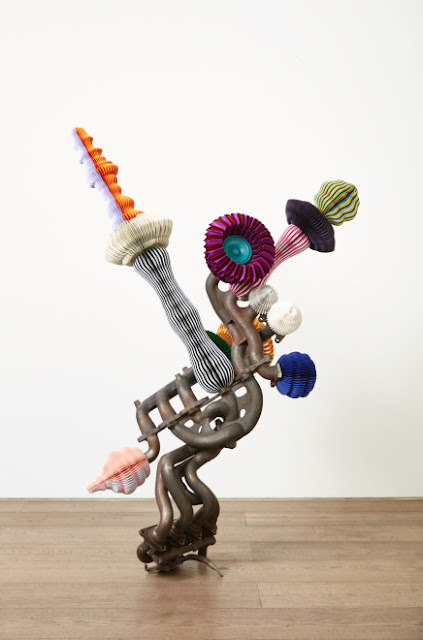
Keita Miyazaki:Collision of Species, 2017 – car parts, felt, paper, stainless steel, speaker system 155x110x78cm
This show puts forward a neat theme – the surprising combination of materials – and makes a stimulating choice of artists who use that approach for their own interesting reasons. Keita Miyazaki provides the ideal start by reconciling discarded car engines with paper folded origami-style. Continuing with tough meets fragile, Brazilian Túlio Pinto balances rock against glass with elegant drama. Felicity Hammond melds metal and concrete with photography. Alice Cattaneo’s glass and wood wall sculptures function a little like paintings, whereas Jane Bustin’s paintings edge towards sculpture with limewood, chiffon, crystal and copper included in Fluorite, 2017. And Leonardo Drew, the most established artist here, fixes large chunks of wood and mis-shapes of aluminium onto heavy paper.

Túlio Pinto:Complicity # 14, 2017 -steel beams and blown glass
98x120x165cm
______________
Hans Kotter: Point of View @ Patrick Heide Contemporary
Art,11 Church St – Marylebone
To 13 Jan
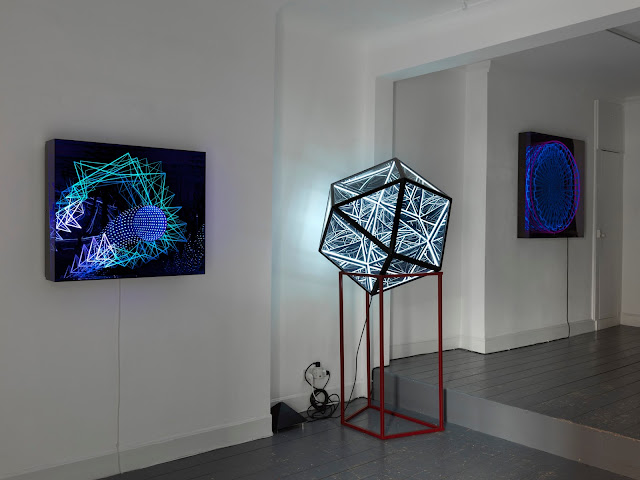
Installation view (photo Marcus Leith)
The gallery is celebrating its tenth year with a substantial and attractive book which reveals how Patrick came to sign up each of the 33 artists he has represented, and builds to an account of how they have taken his underlying preference for the language of abstract drawing in innovative and consistently delicate directions. The German post-Zero artist Hans Kotter is on to his fourth solo show. He draws with light, and impresses with the range of ways in which he transforms his works’ immediate environments through colour changes, illusions of depth and cyclical movement. There’s also some gentle humour in Practicing (Diptych), not a note I recall from before, and the chance to learn what a cuboctahedron looks like.
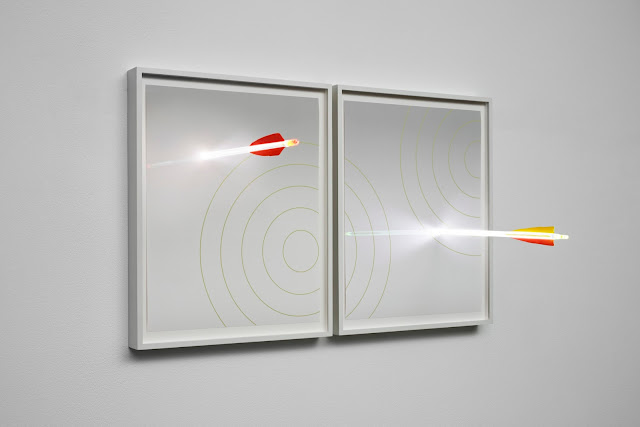
Practicing (Diptych), 2016-17
______________
Marie Harnett: Still @ Alan Cristea Gallery, 43 Pall Mall – Central
To 6 Jan
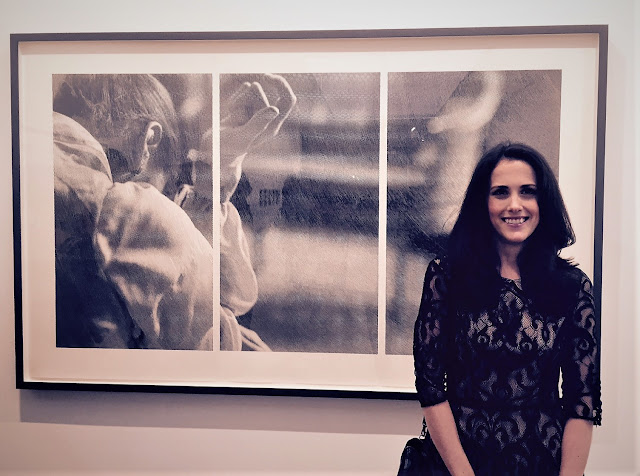
Marie Harnett with the linocut Grief, 2017
Here Marie Harnett, known for her ravishingly detailed small drawings of films, extends her scale and material scope and the ways in which production and cinematic times relate. The frozen moment images are – still – all taken from film trailers, Harnett preferring not to have her choices influenced by the whole movie’s narrative, but the graphite works range from postage stamp to cinema screen sizes. They include Picabaesque ‘overlap drawings’ (as below), taken from frames in which one scene cuts to another; and some extensive abstract passages. She’s also made large linocuts which use curved lines, suggesting fingerprints on celluloid filmstrips held up for inspection: they look like plenty of work, so it’s bracing to learn that a 15 x 10cm drawing takes her as long as cutting a two square metre triptych. The artist also reveals not her hand but her sources’ hands in the short film (or is a trailer?) ‘Hands’, collaged from – you guessed it – film trailers.
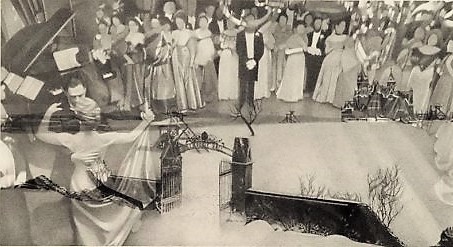
Allerdale Hall, 2016 – Pencil on paper, 8 x 15cm
______________
Drift @ JGM Gallery, 24 Howie St – Battersea
To 20 Jan

Phillip Hunt: Paperjet 4, 1999-2018
Niko Kos Earle pulls off a refreshingly ambitious show in JGM’s sparkling new space: very big work brought in from across the world, united by an abstract intensity bordering on the spiritual, and by how the four artists have – in the titular theme – drifted around the world, between ways of being, and into different materials. It hangs together beautifully as, for example, Lluís Lleó, just returned to Spain from America, achieves a monumental delicacy on paper; Suki Jobson repurposes old dresses discovered in her Irish birthplace; Anglo-New Zealander Simon energises architectural from with implied movement; and Cape Cod based Phillip Hunt revisits work he made in South Africa last century to intoxicating effect *.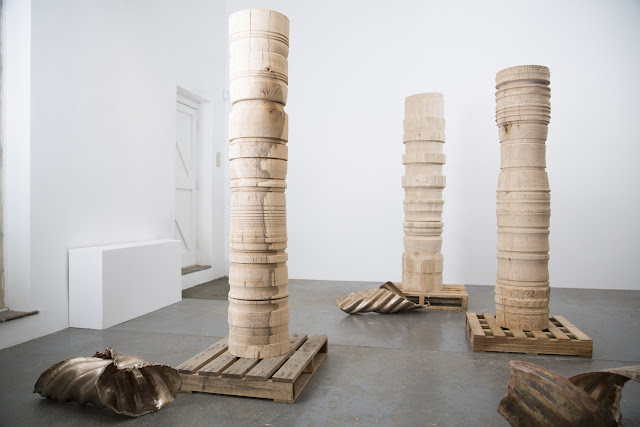
Simon Allison: Spin Cycle and Debris, 2016
* bias alert: I helped a little with the show – you can see a fuller account of it here.
________
XVII: The Age of Nymphs @ Mimosa House, 12 Princes Street – Oxford Circus
To 13 Jan

Upper installation view with Nika Neelova, Folded Rooms, perimeter of studio traced in stainless steel and wax and folded, 2017 – Photo: Damian Griffiths
A surprisingly extensive and central new project space makes the most of its unusual set-up here through a Russian-oriented show which has an underworld, a transitional corridor and a more ethereal upper zone, all tied in to the number 17 – as in the anniversary of 1917’ revolution, the number of years Putin has been in power, and the time cicadas spend underground prior to their ‘resurrection’ for a month of mating. Olga Grotova’s films hook us into the cyclic calm of nuns who look as if they’ve stepped out of a Helmut Newton photo; Nika Neelova turns the topography of a shucked-off exoskeleton hanging below into a coolly folded room above; Yelena Popova provides both apparently evaporated portraits, as from the deep past, and an empty cut-out awaiting future faces; undeterred by their lack of tymbals to flex and wings to flick, Neelova and Mira Calix team up to imitate both male and female cicadas in the corridor, crossing sex and species boundaries and referencing the mythical transformation of people into the insects when first introduced to and overpowered by music. Does it all cohere? I’m not sure, but it’s certainly worth the pondering.

Lower installation view with Olga Grotova, The Ice Rink, video, sound, 11’40, 2017 and Nika Neelova, Exuviae, 2017 – Photo: Damian Griffiths.
______________
Nature Morte @ Guildhall Art Gallery, Guildhall Yard – City of London
To 2 April 2018, £8: Visit Here
Caroline McCarthy: Vanitas, 2007
The large but little known Guildhall Art Gallery has a significant collection of Victorian paintings, currently complemented by and integrated with over 100 contemporary still lives. They provide new spins on flora, vanitas, food and domestic objects in a show – organised by Peckham’s MOCA – which toured the world three years before arriving in London. You’ll find, Andro Semeiko’s 1.5m square “Very big chocolate cake”, a tribute to potential excess, more healthily topped by a 2 m high painting of cherries by Martin Gustavsson; and library of woodland books by Conrad Bakker; a Fright Wig made from household dust by Paul Hazelton; Caroline McCarthy’s image of a skull made from Ben-Day dots punched out of a binbag hung next to it, waste to waste; and two classic Fantin-Latour florals – while both Philip Pirolo and Michael Petry (also the lead curator) make striking works which equate flower and anus.
Michael Petry: Red Roses, 2009 – one of three blown glass and cut flower arrangements in which the rim of the vase is taken from online submission of anus shapes, and each flower choice represents a man’s sexual preferences via the 1970’s gay hanky colour code.
______________
Images courtesy / copyright the relevant artists and galleries Top Photo: Rose Wylie @ Serpentine Gallery P C Robinson © Artlyst 2018

